Essential Components of Surf Kits for Kiteboarding
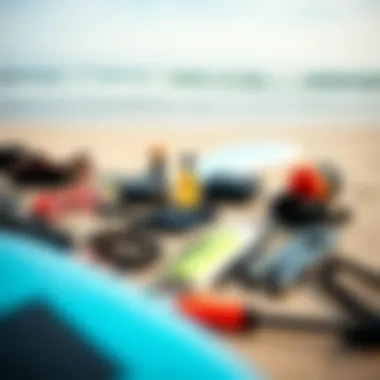
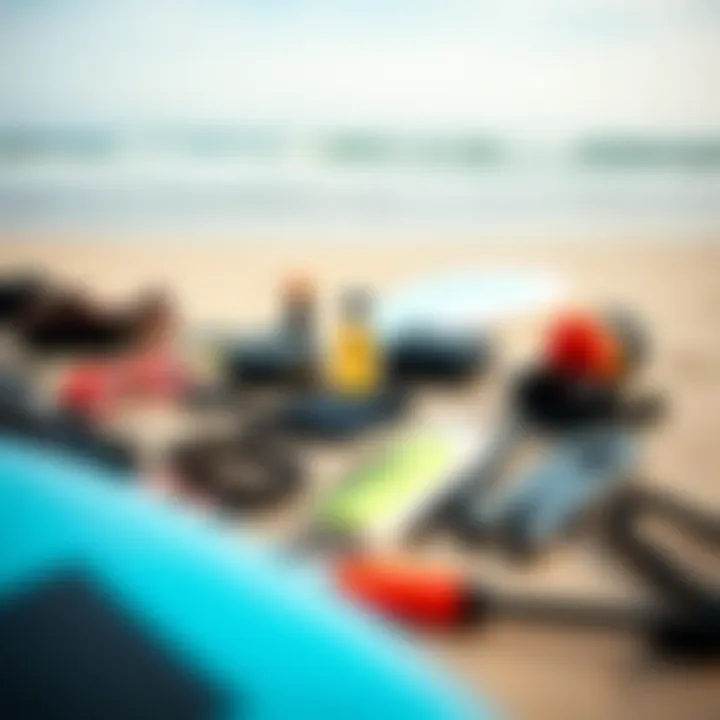
Intro
Kiteboarding, often regarded as one of the most exhilarating ways to embrace the ocean, comes with its own set of requirements to ensure a safe and enjoyable experience. The surf kit is the prime vehicle that takes your kiteboarding adventures to new heights and helps you navigate the waves with confidence. Having the right gear can mean the difference between a thrilling ride and a risky outing.
In this exploration of surf kits, we’re going to dissect the elements that comprise these essential tools, weigh their importance for both performance and safety, and guide you on how to make informed decisions tailored to your individual needs. Whether you're a fresh face on the beach or someone who's already carved a path through the waves, there'd be something here for you.
Let’s not kid ourselves: kiteboarding can be a wild sport. The proper equipment isn’t just a bonus; it's a necessity. From the kite to the board, each piece plays a role in shaping your experience.
As we dive deeper into the nuances of surf kits, we'll not only look at the latest innovations in the technology of kiteboarding gear but also delve into the upkeep that helps your equipment stand the test of time. Keep your eyes peeled for valuable tips aimed at maximizing your kiteboarding escapades.
Navigating through safety precautions is equally vital, so we'll be addressing what you might overlook when assembling your surf kit. After all, a seasoned kiteboarder is a smart one, and preparation is half the battle.
Without further ado, let's lift off into the essential gear and equipment every kiteboarding enthusiast should know about.
Foreword to Surf Kits
When the wind picks up and the waves start rolling, every kiteboarder knows it’s time to grab their surf kit and head for the water. But what exactly makes up a surf kit? Understanding the importance of surf kits is crucial for both novices eager to dive into the sport and seasoned riders seeking to improve their performance. These specialized sets of equipment are not just toys; they are essential tools that enable riders to harness the power of wind and waves for a thrilling experience.
Definition of Surf Kits
A surf kit, in its simplest form, is a collection of gear designed for kiteboarding, which combines aspects of both surfing and wind sports. Most folks picture it as a configuration that includes a kite, a board, a harness, lines, and other accessory gears. Imagine it like a chef’s knife set; each piece is essential for creating a successful dish, or in this case, navigating the seas. The kite captures the wind, the board supports the rider, and the harness connects the two, ensuring that each component works in harmony. Without any one of these pieces, the experience can be significantly compromised.
Importance of Surf Kits in Kiteboarding
Understanding the significance of having a well-matched surf kit is vital for your safety and enjoyment. Here are a few points to ponder:
- Safety First: A quality surf kit not only enhances performance but also plays a major role in keeping you safe on the water. Inexperienced riders can find themselves in challenging situations, and having reliable gear can lessen the risk of accidents.
- Performance Matters: The right combination of equipment can drastically improve your ride. Certain kites are designed for specific wind conditions, and certain boards can enhance various riding styles. Choosing unsuitable gear can lead to frustrating experiences out on the water.
- Personalization: As each kitesurfer has unique preferences and styles, customizing your surf kit is essential. Understanding your requirements allows you to select equipment that not only complements your skills but also elevates your experience.
Overview of Essential Components
A complete surf kit typically comprises several crucial components, each serving a specific purpose:
- Kite: The star of the show, designed to capture the wind. Kites come in various shapes and sizes, tuned for different conditions and riding styles.
- Board: The rider's platform, which can vary in size, shape, and construction material. Choosing the right board can significantly affect maneuverability.
- Harness: Acts as a bridge between the kite and the rider. It allows for greater control and comfort during rides.
- Lines and Control Systems: These components connect the kite to the harness and control the kite’s movement. High-quality lines can improve responsiveness and durability.
- Accessories: Items like safety leashes, pumps, and repair kits are often overlooked but are essential for maintaining your gear.
By diving into the realm of surf kits, you not only equip yourself with the knowledge necessary for making informed decisions but also set the stage for safer and more enjoyable kiteboarding adventures. Whether you are just starting or looking to upgrade your current gear, understanding these key components will pave the way to success on the water.
Core Components of a Surf Kit
Understanding the core components of a surf kit is crucial for anyone engaged in kiteboarding, whether you're just dipping your toes in or already riding the waves like a pro. Each element of the kit plays an integral role in enhancing performance, ensuring safety, and allowing for optimal enjoyment on the water. It's not merely about having the right gear; it's about knowing how each piece operates together to create a seamless experience on the waves.
The Kite: Analyzing Different Types
The kite is arguably the heart of the surf kit, providing lift and thrust, enabling the rider to zip across water and gain speed. Kites come in various shapes and sizes, each designed to cater to different styles and conditions. For instance, C-kites have a more curved shape, promoting a solid grip when jumping or tricking, making them a favorite among freestyle riders.
In contrast, bow kites offer a more stable ride with a larger surface area, better for those just starting out or looking for a steady cruise. The choice of kite should align with individual skill level and the environmental conditions. Go out on the water without the proper kite for the day, and you might as well be paddling on a door.
The Board: Varieties and Selection
Selecting the right board can feel like trying to find the perfect pair of shoes. With options ranging from directional boards to twin-tips, each style serves a different purpose. Directional boards are typically intended for wave riding, resembling surfboards more closely, whereas twin-tips are symmetrical and allow for riding in either direction, making them versatile for beginners and tricksters alike.
When choosing a board, consider the size based on your weight, the type of riding you plan to do, and your personal preference for riding style. Also, the boards can vary in materials, from wood to carbon fiber, impacting durability, weight, and performance. The stakes are high—get the board wrong, and you may find yourself battling the tides instead of dancing with them.
Harness: Chain of Comfort and Control
The harness is the unsung hero of the surf kit, often overshadowed by the flashier components. It connects you to the kite and plays a significant role in your comfort and control on the water. There are two main types: waist harnesses and seat harnesses. While waist harnesses allow for significant mobility, seat harnesses provide extra support, crucial for lighter riders or those new to the sport.
The fit of the harness should be snug without constricting, like a security blanket that you can count on in wild conditions. The right harness will not only improve your handling but also reduce fatigue, letting you spend more time capturing those perfect waves and less time nursing aches and pains.
Lines and Control Systems: Functionality and Quality
Finally, we come to the lines and control systems, often overlooked but vital in ensuring that your kite behaves as it should. The lines are typically made from strong, lightweight materials that resist abrasion and stretching. It’s essential to regularly inspect them for wear and tear because damaged lines can lead to accidents or loss of control.
As for the control system, this includes the bar and the safety features that allow for quick release if things go sideways. High-quality systems provide responsiveness, enabling smooth adjustments to the kite's position—a necessity in changing wind conditions. A faulty control mechanism could put you in a precarious situation, so pay thoughtful heed to quality.
Remember, in kiteboarding, your gear is an extension of yourself. A sound understanding of each component not only amplifies enjoyment but enhances safety and performance, ensuring every ride is memorable.
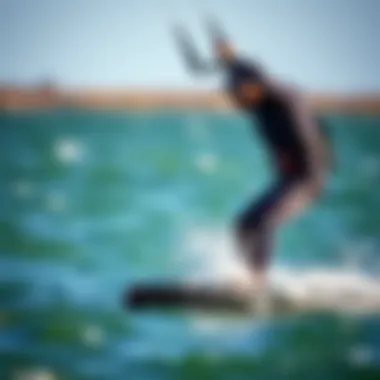
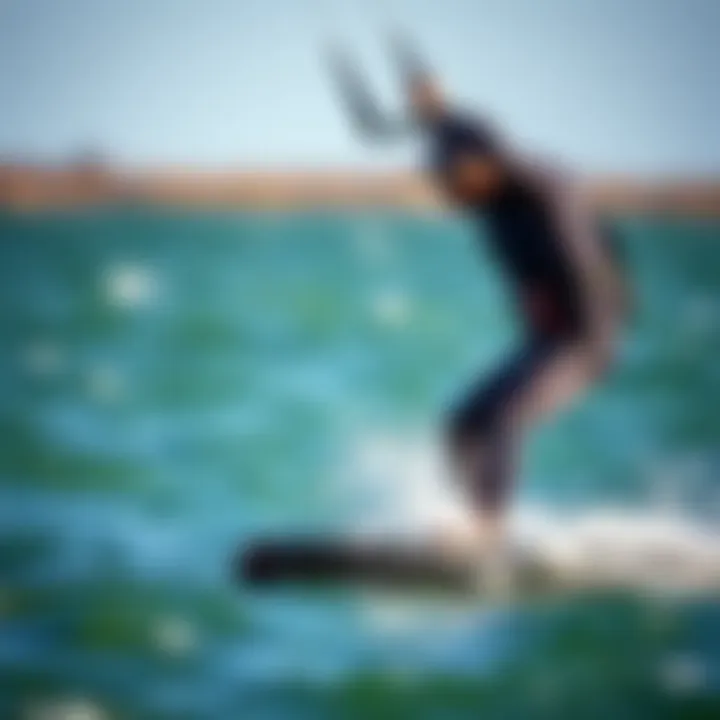
Choosing the Right Surf Kit
Selecting the right surf kit is much more than just picking a random collection of gear; it’s about aligning your choices with your ambitions, abilities, and the environments you'll tackle. In kiteboarding, an appropriate surf kit means the difference between feeling at ease on the water and battling against it. The right components not only enhance your experience but can also improve safety and performance.
Assessing Personal Skill Level
When it comes to kiteboarding, knowing where you stand in terms of expertise is crucial. Novice riders will do better with gear that is forgiving and easy to control, while seasoned surfers might crave advanced features that allow them to push their limits.
A beginner may find larger kites more manageable, as they provide better lift and stability, while an expert might want smaller kites for speed and precision. Take time to reflect on your personal comfort zone, and be honest about what skills you possess. It's a fine balance; pushing too far too fast can lead to accidents and frustration.
- Beginners: Look for a kite with a high aspect ratio for stability.
- Intermediate: Seek a balance between size and maneuverability.
- Advanced: Consider performance-focused boards with precise kite control.
Understanding Environmental Conditions
Weather and water conditions play a critical role in gauging the surf kit's effectiveness. Not all kites and boards perform equally well in varying environments. It’s essential to comprehend how wind intensity, water conditions, and local climates interact with your gear.
- Wind intensity: High winds may necessitate smaller kites; light winds would benefit from larger ones.
- Water conditions: Rough seas can overpower smaller boards, making broader options preferable in those scenarios.
- Local climate: Places with unpredictable gusts require gear that can handle a range of conditions.
Understanding these factors will not only enhance performance but also serve as a protective measure against potentially harmful situations.
Budget Considerations
When it comes to investing in a surf kit, finances inevitably come into play. The world of kiteboarding can be pricey, but buying on a budget doesn't mean you have to compromise on quality. Set clear priorities: What’s non-negotiable in your kit? A well-functioning kite is more crucial than the latest fashion in colors.
- Consider used equipment; many riders frequently upgrade their gear, providing ample opportunities to snag a deal on quality items.
- Look into brands with good reputations for durability, as a higher upfront cost can save money long-term.
- Invest in core essentials before luxury items—your safety and performance should take precedence.
Exploring Package Deals vs. Individual Purchases
As you contemplate how to put together your surf kit, the choice between acquiring a package deal or individual components arises. Package deals often present a cost-effective solution, bundling essential gear at a lower price than purchasing each component separately. However, they may not always cater to your specific needs or preferences.
- Package Deals:
- Individual Purchases:
- Pros: Generally cheaper; time-saving.
- Cons: May lack specific brands or types you prefer.
- Pros: Customizable to your liking; allows for better quality choices.
- Cons: Can add up quickly; requires more extensive research.
In the end, whether to opt for a package or go solo will come down to weighing values—consider your priorities, style preferences, and budget limitations.
Choosing the right surf kit is like finding the right puzzle pieces; they need to fit together perfectly for you to enjoy your kiteboarding journey.
Innovations in Surf Kit Technology
As the kiteboarding scene evolves, so does the technology behind surf kits. These innovations not only enhance performance but also cater to safety and user experience. Understanding the advancements in surf kit technology is critical for anyone looking to elevate their kiteboarding skills. This section delves into notable developments that have revolutionized how enthusiasts interact with their gear, focusing on both new materials and the integration of smart technology.
Advancements in Materials
Material advancements have played a pivotal role in transforming surf kits. Gone are the days when heavy and bulky components ruled the market. Modern kits use lighter, more durable materials making it easier for riders to achieve better control and performance. Here are some key materials making waves today:
- Dyneema® Lines: Known for their high strength-to-weight ratio, Dyneema lines resist abrasion better than traditional materials. That means fewer mid-session replacements and more time on the water.
- Carbon Fiber Boards: Renowned for their lightweight and robust nature, carbon fiber boards provide better responsiveness and maneuverability, making them suitable for both beginners and seasoned kiteboarders.
- Ripstop Fabrics: Utilized for kites, these materials prevent tearing and have become standard in high-performance kites. Plus, they keep the kite lightweight, making launches easier.
The combination of these materials creates kits that are not only efficient but also environmentally friendly. As kiteboarding continues to grow, businesses are looking for ways to reduce their carbon footprint while maintaining performance standards.
"Investing in a high-quality surf kit using modern materials can mean the difference between a decent and fantastic experience on the water."
Smart Technology Integration in Kits
The incorporation of smart technology into surf kits marks a significant change in the sport. Tools that once seemed futuristic are now commonplace, enhancing safety and performance. Devices such as anemometers and GPS trackers can now be easily integrated into your surfing experience, offering insights while you're on the water. Consider the following:
- Kite Control Systems: Some manufacturers are introducing systems that respond to changes in wind conditions automatically. This is not just a luxury; it enhances safety by taking the guesswork out of kite control.
- Wearable Tech: Devices that provide real-time data on heart rate, speed, and altitude are making their way into the surf kit realm. By tracking these metrics, riders can assess their performance and push their limits thoughtfully and safely.
- Mobile Apps for Navigation and Monitoring: Many brands are developing apps that sync with their products to provide live updates on weather conditions, tidal movements, and even local hotspots for kiteboarding.
The integration of such technology enriches the overall kiteboarding experience and supports a more informed approach to riding. As you look into purchasing a surf kit, evaluating these aspects can lead to a vastly improved relationship with the sport.
In summary, innovations in surf kit technology reveal a trend towards enhanced performance, safety, and overall experience. Whether you're drawn by the lure of new materials or the thrill of smart integrations, these advancements provide a pathway to pushing your kiteboarding skills further.
Maintenance of Surf Kits

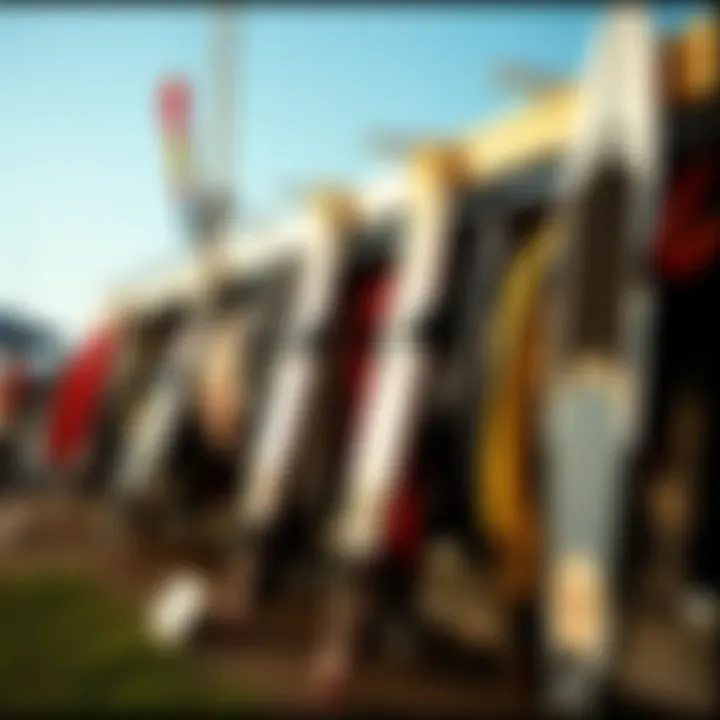
Maintaining surf kits is not just a good practice; it's essential for maximizing longevity and performance. Just like any vehicle or piece of equipment, surf kits benefit greatly from regular maintenance. A well-kept kit offers better performance, improved safety, and an overall more enjoyable riding experience. Whether you're a newbie just getting your feet wet or a seasoned pro, knowing how to care for your gear will go a long way.
Care for Kites and Boards
Taking care of your kite and board requires attention to detail. It might seem tedious at times, but the benefits are well worth it. Here are several key practices:
- Rinse with Fresh Water: After your surfing session, it’s crucial to rinse the kite and board with fresh water to remove saltwater, sand, and debris. This simple step helps prevent corrosion and wear.
- Check for Damage: Each time you handle your kite and board, perform a quick visual inspection for tears, frayed lines, or any other visible signs of damage. Early detection can save you a headache later.
- Dry Properly: Let your gear dry completely before storing it. Folding wet kites or boards can create damp spots that may lead to mold or mildew, ruining your equipment over time.
- Store in a Cool, Dry Place: Keeping your surf kit in a temperature-controlled environment can help extend its lifespan. Avoid exposing your gear to harsh sun or cold temperatures for extended periods.
- Use Kite Bags: Invest in high-quality kite bags or padded board bags for transport. This protects your gear from dents, scratches, and impacts when travelling.
Inspecting Lines and Control Mechanisms
Lines and control systems are the lifeblood of your surf kit. If these components fail, it can have serious consequences. Regular inspections help to ensure a safe and seamless experience:
- Visual Check: Inspect the lines before every session. Look for frays, knots, or abrasions which could weaken them significantly. If anything looks off, consider replacing them.
- Kilograms of Tension: Understand the amount of tension these lines can handle. If they seem loose or too tight, adjust them accordingly. Proper tension can make a world of difference in flight stability.
- Control Bar Functionality: Ensure that the control bar functions smoothly. Sticky bars or faulty depower systems can lead to an uncontrolled flight. Give it a good twist and pull to check for any inconsistencies.
- Safety Systems: Familiarize yourself with your safety mechanisms regularly. Know how to activate them in case of emergencies. Make sure they are not obstructed and function properly.
In the words of a seasoned kiteboarder, "An ounce of prevention is worth a pound of cure." By investing time into the regular maintenance of your surf kit, you not only enhance safety but also elevate your overall riding experience. To dive deeper into the intricacies of kiteboarding gear and maintenance, explore further by visiting resources such as Wikipedia or engage with communities on Reddit.
Taking care of your surf kit ensures that you're not just riding the waves but doing so with peace of mind.
Maximizing Performance Through Proper Usage
When it comes to kiteboarding, just having the right equipment isn’t enough; knowing how to properly use that equipment is equally, if not more, crucial. The performance of a surf kit hinges not just on its components, but on the skills of the person wielding it. Mastering your technique can make the difference between a thrilling ride and a harrowing experience. In this section, we will delve into the essential practices that elevate performance and enhance safety on the water.
Techniques for Improving Control
Control is the name of the game in kiteboarding. It’s the fine balance between managing your kite and maneuvering your board that enables skilled riders to harness the wind effectively.
- Stance and Body Positioning: Your stance can significantly affect your control. Keeping your knees slightly bent while maintaining a relaxed upper body can help absorb the choppy water, allowing for better handling of the kite.
- Two-Handed Steering: Always use two hands on your control bar in tricky conditions. This might sound simple, but ensuring you’re gripping the bar firmly and using both hands can allow for more nuanced steering. Wherever possible, practice your steering movements to develop a seamless connection with your kite.
- Finesse with the Bar: Adjusting how you pull or release the bar can change the kite’s behavior in the air. Quick pulls can create immediate power, while gradual releases can decrease pull subtly. Finding that sweet spot requires practice, but it pays off when it comes to controlling your speed and trajectory.
- Utilize Your Core: Engage your core muscles while riding. This can help you maintain balance and better execute quick adjustments as needed. A stable core makes for sharper turns and more controlled jumps.
"It's not just about the kite, but how you move with it" – a mantra for any kiteboarder striving for mastery.
Adjusting Your Kite for Optimal Conditions
Getting the most out of your surf kit means noticing the weather and adjusting your kite accordingly. Conditions can change with the blink of an eye, and being adaptable is key to an enjoyable experience.
- Wind Conditions: Before heading out, assess the wind strength. For lighter winds, consider using a larger kite since it will catch more breezes, providing you with the propulsion needed. Conversely, a smaller kite can be advantageous in strong winds to avoid being overpowered.
- Trimming the Kite: Adjusting the trim on your kite can optimize its performance. By changing the position of the lines, you can set the kite for different styles of riding or environmental conditions.
- Angle of Attack: Changing the angle of your kite relative to the wind can also maximize lift and control. In light winds, aim for a higher angle, but bring it down some in stronger winds for better stability.
- Assessing Your Setup: Frequent checks on your lines and connections can prevent mishaps. Always inspect everything before heading out to make sure your setup is secure for the conditions.
In understanding the dynamics at play while kiteboarding, you can enhance not only your experience but also the longevity of your surfing gear. Proper usage of surf kits isn’t merely a technical skill; it stands as a dedicated practice that intertwines an understanding of the equipment with the responsiveness of the rider.
Safety Considerations
When it comes to kiteboarding, understanding safety considerations should be at the forefront of any discussion related to surf kits. Whether you’re a greenhorn or a seasoned kiter, prioritizing safety isn’t just a good practice; it’s essential for ensuring a fun and successful ride. Each time you hit the air or skim your board across the water, various risks can creep up. From erratic weather patterns to unpredictable water conditions, the spectrum of potential hazards is quite broad. Therefore, being well-prepared with the right knowledge, equipment, and mindset is crucial.
Essential Safety Gear
The right safety gear can be the thin line between a good day on the water and a harrowing experience. It’s vital to equip yourself properly, and here are a few essentials you shouldn't skimp on:
- Helmet: Protect your noggin from sudden falls or impacts. Most helmets designed for kiteboarding are lightweight and offer excellent protection without sacrificing comfort.
- Impact Vest: While they offer some buoyancy, impact vests primarily protect your ribcage and torso from hard landings. Look for one that fits snug but allows for a full range of movement.
- Safety Leash: This piece of equipment serves as a lifeline. If you get separated from your kite, a safety leash can prevent it from wandering too far away, potentially causing accidents.
- Personal Flotation Device (PFD): While not obligatory for everyone, having a PFD can be a lifesaver, especially in rough waters. It gives you the extra buoyancy needed to help keep your head above water.
By investing in these essential safety items, you’re not just protecting yourself but also enhancing your overall kiteboarding experience.
Understanding Risk Factors
To navigate the thrill of kiteboarding safely, you need to have a solid grasp on the risk factors associated with the sport. Ignorance often leads to errors, but awareness allows for better preparedness. Here are some critical elements to keep in mind:
- Weather Conditions: Always check wind speeds, as strong or gusty winds can lead to unexpected challenges. Winds that are too light can leave you stranded, while winds that are too strong can blast you off course. Understanding the type of weather patterns in your chosen location is essential.
- Water Conditions: Beaches can vary significantly based on tides, currents, and underwater obstacles. Knowledge of local tides and currents can prevent nasty surprises, like being swept away or hitting submerged rocks.
- Skill Level Compatibility: Make sure you’re aware of your own abilities. What might be a fun challenge for an advanced kiteboarder can be downright dangerous for a novice. Using equipment suited to your skill level can greatly influence safety.
"Preparation is key to safety; knowledge is your best ally." Being prudent about these factors helps mitigate risks associated with kiteboarding, ensuring that your adventures remain exhilarating yet secure.
Exploring Top Kiteboarding Destinations
The world of kiteboarding is as vast and diverse as the ocean itself. Choosing the right location to surf can determine the quality of the experience immensely. Destinations for kiteboarding not only influence the potential for performance but also play a significant role in personal enjoyment and safety. Each locale brings its own unique wind patterns, wave conditions, and scenic beauty, which can either enhance or detract from the kiteboarding experience. Moreover, knowing where to go can help you meet others with the same passion, making for a more enriching adventure.
In this section, we will explore some of the top kiteboarding spots around the globe, highlighting what makes each place special and offering some essential kit recommendations tailored for those locales. The importance of balancing personal preference with the specific characteristics of each destination cannot be overstated, as this balance ensures a thrilling and memorable kiteboarding journey.
Best Locations for Surfing
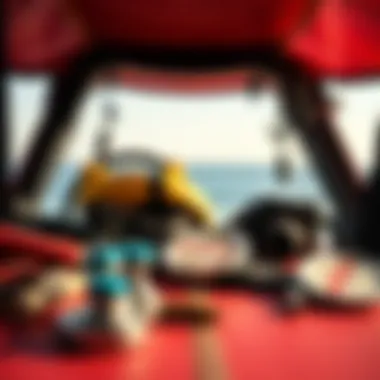
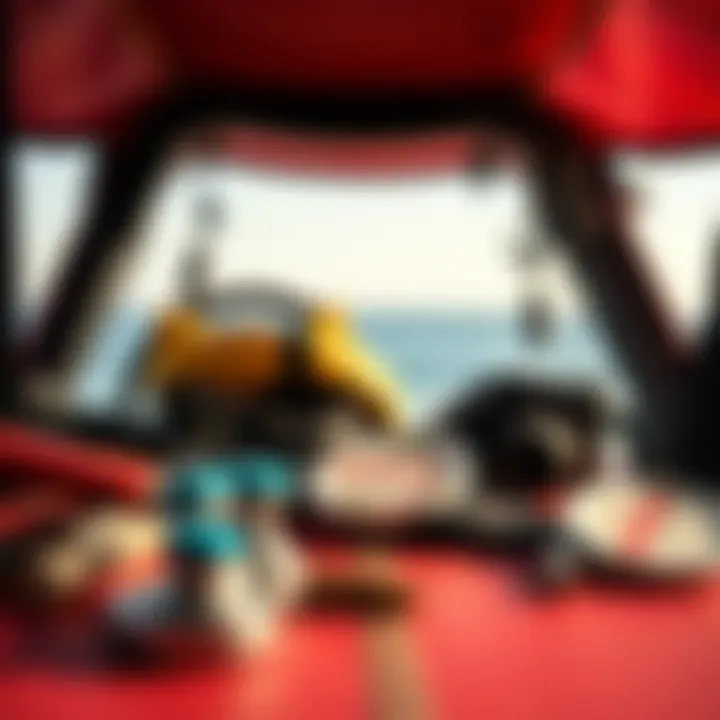
When it comes to kiteboarding, the place can either make or break your vibe. Here is a selection of the top locations that every kiteboarder should consider:
- Cabo Verde, Africa: Known for its steady winds and warm waters, Cabo Verde has become a favorite for many kiteboarders. The islands provide a variety of spots suitable for all skill levels, from flat water at Sal to the challenging waves of Ponta Preta.
- Tarifa, Spain: Often dubbed the "Kiteboarding Capital of Europe," Tarifa boasts strong winds almost year-round. With stunning beaches and a vibrant atmosphere, it’s a hotspot for both amateurs and pros.
- Hood River, Oregon, USA: Located on the Columbia River Gorge, Hood River is renowned for its stunning landscapes and powerful river winds. This area offers a unique combination of river and mountain scenarios that attract enthusiasts from various backgrounds.
- Boracay, Philippines: A tropical paradise, Boracay features both flat water and waves. The island is famous for its white sand beaches and friendly local scene, which makes it a great destination for kiteboarders looking for leisure.
- Maui, Hawaii: A classic for many water sports, Maui provides world-class surfing conditions alongside some fantastic kiteboarding spots. The diverse wind conditions here allow for thrilling rides on both waves and flat water.
Each location offers its own charm, yet they all promise exhilarating experiences. Kiteboarders may find themselves gaining invaluable skills as they adapt to the distinct elements presented by each environment.
Destination-Specific Kit Recommendations
When packing for your kiteboarding adventure, it’s important to remember that not all gear is suitable for every location. Conditions such as wind strength, water type, and wave size can influence what equipment you should bring. Here are some tailored kit recommendations for the above-mentioned destinations:
- Cabo Verde: Consider packing a 9-12 meter kite depending on the season. A lightwind board will be useful if the winds are lighter than expected. Additionally, don’t forget your sunscreen; the sun can be unforgiving in Africa.
- Tarifa: For Tarifa’s strong winds, bring a 7-9 meter kite alongside a directional board for the waves. An impact vest could also be a smart addition for the strong shore break.
- Hood River: The river conditions can be more sheltered, so a larger kite (10-12 meters) will serve you well, along with a freestyle board to help you navigate any tricky chop.
- Boracay: Ideal for various conditions, a versatile 8-10 meter kite will be a good choice. Flat-water boards can make beginner sessions much enjoyable, especially if wind conditions are more modest.
- Maui: Bring both a wave kite (7-9 meters) and a freestyle option (9-11 meters), as the island offers mixed conditions. A shortboard suitable for both surfing and kiteboarding would definitely elevate your experience.
Importantly, before heading to any of these locations, check local regulations and get familiar with the local kiteboarding guidelines to ensure a safe and thrilling ride.
"Selecting the right destination not only enhances your skills but also enriches your overall experience, making kiteboarding a thrilling endeavor full of adventure and camaraderie." - Extract from local kiteboarding community insights.
In closing, understanding the interplay between destination, conditions, and equipment can significantly enhance your kiteboarding endeavors. Each kiteboarding spot presents a unique tapestry of experiences, waiting to be explored with the right kit and an adventurous spirit.
For more information on kiteboarding destinations, you can check resources such as Wikipedia or Reddit.
Community and Resources
In kiteboarding, community and resources hold a great deal of significance, acting as a lifeline for both novice and seasoned kiteboarders. Engaging with others not only enhances your learning experience but also fosters a shared passion. The kiteboarding community is diverse, encompassing people of all ages and backgrounds, each bringing unique insights and techniques to the table. Leveraging this collective knowledge is beneficial, especially in a sport where conditions can vary significantly from one location to another.
Furthermore, resources available online offer a wealth of information that can steer kiteboarders in the right direction. From safety tips to gear reviews, the internet is brimming with valuable content to elevate your skills on the water. Embracing both community interaction and digital resources can provide an edge in not just proficiency but also safety and overall enjoyment in kiteboarding.
Connecting with Other Kiteboarders
Connecting with fellow kiteboarders can profoundly influence your experience. Local meetups at beaches are brilliant opportunities to make friendships while learning from others. Sharing tips, stories, and the occasional fail can lead to continuous improvement.
Social media platforms are also significant connectors in this sport. Facebook groups dedicated to kiteboarding often have threads where enthusiasts share their best practices, location advice, or even organize group outings. Engaging in such groups helps build camaraderie and a shared sense of community.
Benefits of Connecting:
- Knowledge Exchange: Learning from others' experiences can save you from common pitfalls.
- Support Network: Having a group to turn to for advice or motivation makes the sport more enjoyable.
- Planning Adventures: Coordinating trips with like-minded individuals enhances the thrill of kiteboarding.
"The strength of the team is each individual member. The strength of each member is the team."
Online Forums and Support Groups
Online forums serve as a modern-day town hall for kiteboarders. Websites like reddit.com/r/kiteboarding or specialized forums allow users to ask questions, share tutorials, and find partners for their next adventure. The beauty of these forums lies in their accessibility; at any hour of the day, you can connect with someone who has faced similar challenges or can provide insight on the latest gear.
In addition to forums, dedicated support groups can be invaluable. For instance, there are platforms on websites such as facebook.com where groups focus strictly on safety, gear maintenance, and empowering beginners. Newcomers can seek guidance without the fear of judgment, knowing everyone was a beginner at some point.
Key Elements of Online Communities:
- Anonymity: Allows for open discussion of struggles or questions without feeling hesitant.
- Resource Sharing: Members often share links to articles, video tutorials, or events happening in nearby areas.
- Encouragement: A supportive environment that promotes progress and learning.
In summary, a vibrant community paired with reliable online resources transforms kiteboarding from a solitary sport to a collective journey. Knowing you're a part of something larger can make all the difference in your progression and enjoyment of the sport.
Epilogue
In the realm of kiteboarding, a well-equipped surf kit can be the difference between a thrilling ride and a challenging experience. This article has meticulously unraveled the nuances and essential components of surf kits, illuminating their significance for both safety and performance. By understanding the intricate balance of kit components—from kites and boards to harnesses and lines—kiteboarders can cultivate a richer riding experience, fostering both skill development and enjoyment.
Learning about the various innovations in surf kit technology further accentuates the advantages that modern advancements provide. Integrating smart technology and using advanced materials promises not only superior performance but also enhances the user's connection with the environment, making each session feel seamless. Moreover, the insights provided on maintaining surf kits serve as an invaluable resource that cannot be overlooked. Keeping gear in optimal condition ensures longevity, safety, and reliability.
Lastly, the community aspect of kiteboarding, underscored in this article, brings forth opportunities for mutual learning and sharing experiences. Engaging with fellow enthusiasts, whether through online platforms or local meet-ups, strengthens one's connection to the sport and can significantly influence one's growth as a kiteboarder.
As we wrap up this exploration, the importance of mindful selection of surf kits and continuous skill improvement cannot be overstressed.
Recap of Key Takeaways
- Understanding Components: Each part of the surf kit has a unique role and impacts performance. Knowing what works best together is essential.
- Importance of Maintenance: Regular checks on equipment can prevent accidents and prolong the life of the gear.
- Community and Support: Engaging with fellow kiteboarders fosters growth and adds depth to your experience, providing support through learning and sharing.
- Tech Innovations: New technologies can enhance performance and make the experience more enjoyable.
Encouragement for Continuous Improvement
As any seasoned kiteboarder will tell you, the learning never truly stops. The waves, winds, and environments you find yourself in are constantly changing.
Embrace the journey of becoming a better kiteboarder. Take advantage of online tutorials, workshops, and local community events. Experiment with new techniques and push your limits. You might find that a simple adjustment in your kite tuning or stance can unlock new levels of control and performance.
Remember, every ride is an opportunity to learn something new. No matter your current skill level, there is always room for growth. So gear up, hit the water, and savor every moment in the pursuit of mastering the art of kiteboarding.















